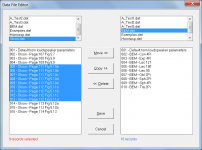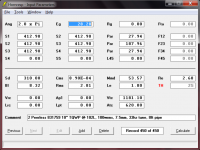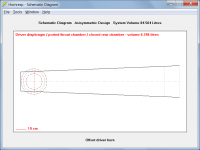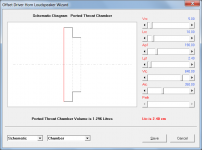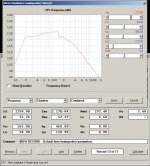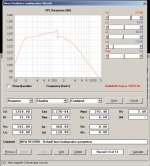Me too, the auto prompt to update is a nice feature, thanks!
Hi GM,
You're welcome
Have you tried using the multiple data files functionality yet? It could come in handy in managing the large number of records that you have. Select File > New to create a new data file or File > Open to load an existing file. Select File > Editor to move or copy records in bulk from one data file to another, or to delete records in bulk.
Kind regards,
David
Attachments
Merry Christmas and all that jive! 
No, for quite awhile now I haven’t used HR [or any other audio related software] hardly at all, just doing updates when I noticed them, but not checking what they were, so will have a lot of catching up to do by the time I can get back to concentrating on my hobbies.
Nice feature though as it allows more selective filtering than the ‘FIND’ file, so thanks again for the continuing upgrades, especially the ones you’ve done despite swearing that for one reason or another they would never happen.
GM
No, for quite awhile now I haven’t used HR [or any other audio related software] hardly at all, just doing updates when I noticed them, but not checking what they were, so will have a lot of catching up to do by the time I can get back to concentrating on my hobbies.
Nice feature though as it allows more selective filtering than the ‘FIND’ file, so thanks again for the continuing upgrades, especially the ones you’ve done despite swearing that for one reason or another they would never happen.
GM
Hi BP1Fanatic,
A question for you - what is your Operating System, and your display screen resolution and text size settings?
I would like to understand why your Hornresp input parameters window is as shown in the first attached screenprint - in particular why the input boxes and text are so large, and why the word "Previous" in the leftmost command button is wrapped over two lines.
The second attachment shows the input parameters window as it normally appears, using Windows 7, a screen resolution of 1600 x 900 pixels and a text size setting of 125%.
Thanks.
Kind regards,
David
Windows Vista, extra large font (i think 150%), LG 1080p 24" monitor connect to my biostar desktop via hdmi to dvi GeForce 7300 graphics card at 1920x1080 resolution. I'm texting from my cell since I'm not home.
especially the ones you’ve done despite swearing that for one reason or another they would never happen.
Hi GM,
I never swear in public - it's not polite
Sometimes though I am pleasantly surprised to find that implementing a suggested change is not as difficult as first thought, in which case I am only too happy to introduce it. Unfortunately however, these days most of the suggested changes tend to be pretty ambitious, and I am finding it increasingly difficult to justify the large amounts of work involved.
Kind regards,
David
Windows Vista, extra large font (i think 150%), LG 1080p 24" monitor connect to my biostar desktop via hdmi to dvi GeForce 7300 graphics card at 1920x1080 resolution. I'm texting from my cell since I'm not home.
Hi BP1Fanatic,
Thanks for this information. I am at a loss to explain why Hornresp appears as it does on your display monitor. In my case with a text size of 150% the input screen is as shown in the attachment.
Another one of life's little mysteries, it seems...
Kind regards,
David
Attachments
No problem guy! I'll get you an accurate description the next time I log onto that computer. I have five computers running in my house. The biostar is the hotrod of the group. You know about the laptop that's kept in the master bedroom. I have an Asus pundit-r running Vista in the garage, a pundit-r running xp in the basement and in my son's room. I use four functional pundit-r's as a stand for 1 of 4 ps3's in the house.
Hi David,
In the newest version: 3020-130101:
When opening a new data file (e.g.: Test.dat) this seems to work OK, but, hitting the Calculate button brings up the Air Chamber Resonances Yes/No/Cancel box, and, after hitting Yes (or NO), the program goes on to the Schematic Diagram window. Going back to the original Hornresp.dat file returns Hornresp to its original function, i.e.: Calculate gets one to the SPL Response window.
Bug?
And "Happy New Year",
Regards,
In the newest version: 3020-130101:
When opening a new data file (e.g.: Test.dat) this seems to work OK, but, hitting the Calculate button brings up the Air Chamber Resonances Yes/No/Cancel box, and, after hitting Yes (or NO), the program goes on to the Schematic Diagram window. Going back to the original Hornresp.dat file returns Hornresp to its original function, i.e.: Calculate gets one to the SPL Response window.
Bug?
And "Happy New Year",
Regards,
is it posible to extend the impulse spectrogram downwards to lets say 10 hz.
Hi epa,
The range of 40Hz to 10kHz was recommended by Jean-Michel (Jmmlc) as providing the best balance between the usefulness of the information displayed, and the time necessary to calculate the results. For this reason, I would prefer not to alter the existing frequency range.
Jean-Michel is the author of the spectrogram routine used in Hornresp.
Kind regards,
David
Hi David,
In the newest version: 3020-130101:
When opening a new data file (e.g.: Test.dat) this seems to work OK, but, hitting the Calculate button brings up the Air Chamber Resonances Yes/No/Cancel box, and, after hitting Yes (or NO), the program goes on to the Schematic Diagram window. Going back to the original Hornresp.dat file returns Hornresp to its original function, i.e.: Calculate gets one to the SPL Response window.
Bug?
And "Happy New Year",
Regards,
Hi Oliver,
When a new data file is created, the default option settings are initially used - these can then be changed using the Tools > Options menu command. Different data files can have different saved settings.
Best wishes for the New Year to you also.
Kind regards,
David
Happy New Year David,
I note that you are receiving numerous requests to extend the functionality of your HR program. In this regard, an offer of a commission (financial reward), organized by those making the requests, might be sufficient encouragement for you to implement them.
TAD uses a resonant cavity in their AFAST Horns to suppress response ripple that increases as horn cut-off frequency [Fc] is approached.
Regards,
Bill
I note that you are receiving numerous requests to extend the functionality of your HR program. In this regard, an offer of a commission (financial reward), organized by those making the requests, might be sufficient encouragement for you to implement them.
TAD uses a resonant cavity in their AFAST Horns to suppress response ripple that increases as horn cut-off frequency [Fc] is approached.
Regards,
Bill
Attachments
... an offer of a commission (financial reward), organized by those making the requests, might be sufficient encouragement for you to implement them.
I don't think that's going to work, he won't even accept donations. I'd love to buy the guy a drink at the very least (or at least forward some $$$ so he can buy his own since I'm on the other side of the world) but he won't accept it.
Fortunately for us there's not much Hornresp can't do, and whatever is left over can be continued in Akabak.
I note that you are receiving numerous requests to extend the functionality of your HR program. In this regard, an offer of a commission (financial reward), organized by those making the requests, might be sufficient encouragement for you to implement them.
TAD uses a resonant cavity in their AFAST Horns to suppress response ripple that increases as horn cut-off frequency [Fc] is approached.
Regards,
Bill
Hi Bill,
And a very happy New Year to you also!
Unfortunately most of the requests now being received would require major modifications to the Hornresp architecture to enable them to be implemented in a rigorous and consistent fashion. It is not a question of financial inducement, but rather the amount of work involved in making any such changes. As you know, the program has evolved significantly over the years, but with little alteration to the fundamental user interface or input parameters. I guess, like me, Hornresp is beginning to show its age...
Kind regards,
David
hi davidHi epa,
The range of 40Hz to 10kHz was recommended by Jean-Michel (Jmmlc) as providing the best balance between the usefulness of the information displayed, and the time necessary to calculate the results. For this reason, I would prefer not to alter the existing frequency range.
Jean-Michel is the author of the spectrogram routine used in Hornresp.
Kind regards,
David
i can imagine that todays computers are fast enough to do the caculations pretty quick.
otoh,its not a necessity
Hi David,
New Year, new requests?
When simulating OD horns I'm using Ap1/Lpt to control the entry into the horn at the S2 location, and this seems to work. I think I'm simulating an entry into the horn with a throat chamber coupling duct that has a cross-section smaller than S2.
I would like to additionally have the ability to simultaneously provide a vent for the rear chamber, similar to the way you solved this for CH, by using S4/S5/L45 for the rear chamber port/horn.
Would that be possible without major modifications?
Regards,
New Year, new requests?
When simulating OD horns I'm using Ap1/Lpt to control the entry into the horn at the S2 location, and this seems to work. I think I'm simulating an entry into the horn with a throat chamber coupling duct that has a cross-section smaller than S2.
I would like to additionally have the ability to simultaneously provide a vent for the rear chamber, similar to the way you solved this for CH, by using S4/S5/L45 for the rear chamber port/horn.
Would that be possible without major modifications?
Regards,
Hi Oliver,
Your thinking is correct. The arrangement can be confirmed by checking the default schematic diagram (Attachment 1), or the Loudspeaker Wizard chamber schematic (Attachment 2).
Unfortunately, no. Definitely another one for AkAbak...
Kind regards,
David
When simulating OD horns I'm using Ap1/Lpt to control the entry into the horn at the S2 location, and this seems to work. I think I'm simulating an entry into the horn with a throat chamber coupling duct that has a cross-section smaller than S2.
Your thinking is correct. The arrangement can be confirmed by checking the default schematic diagram (Attachment 1), or the Loudspeaker Wizard chamber schematic (Attachment 2).
I would like to additionally have the ability to simultaneously provide a vent for the rear chamber, similar to the way you solved this for CH, by using S4/S5/L45 for the rear chamber port/horn. Would that be possible without major modifications?
Unfortunately, no. Definitely another one for AkAbak...
Kind regards,
David
Attachments
David,
I noticed some kind of 'sudden jump' when sliding Vrc and the appearance of 'Helmholtz freq' in the lower right corner. (red color)
The graph suddenly changes a lot too.
Sliding further in the Vrc normally doesn't change the graph a lot, except at this certain point.
Attached are the two screen shots with a Vrc difference of only 0.1
Thank you.
I noticed some kind of 'sudden jump' when sliding Vrc and the appearance of 'Helmholtz freq' in the lower right corner. (red color)
The graph suddenly changes a lot too.
Sliding further in the Vrc normally doesn't change the graph a lot, except at this certain point.
Attached are the two screen shots with a Vrc difference of only 0.1
Thank you.
Attachments
- Home
- Loudspeakers
- Subwoofers
- Hornresp
